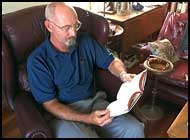| Step 1: Read My Book Review |
Next |
 Here's a review I wrote about one of my favorite books, To Kill a Mockingbird by Harper Lee. Read my review, and try using it as a model as you begin thinking about your own book review. Here's a review I wrote about one of my favorite books, To Kill a Mockingbird by Harper Lee. Read my review, and try using it as a model as you begin thinking about your own book review.
To Kill a Mockingbird
by Harper Lee
Review by Rodman Philbrick
I've never been to Alabama, but novelist Harper Lee made me feel as if I had been there in the long, hot summer of 1935, when a lawyer named Atticus Finch decided to defend an innocent black man accused of a horrible crime. The story of how the whole town reacted to the trial is told by the lawyer's daughter, Scout, who remembers exactly what it was like to be eight years old in 1935, in Maycomb, Alabama.
Scout is the reason I loved this book, because her voice rings so clear and true. Not only does she make me see the things she sees, she makes me feel the things she feels. There's a lot more going on than just the trial, and Scout tells you all about it.
A man called Boo Radley lives next door. Very few people have ever seen Boo, and Scout and her friends have a lot of fun telling scary stories about him. The mystery about Boo Radley is just one of the reasons you want to keep turning the pages to find out what happens in To Kill a Mockingbird.
Scout and her big brother, Jem, run wild and play games and have a great time while their father is busy with the trial. One of their friends is a strange boy called Dill. Actually Dill isn't really so strange once you get to know him. He says things like "I'm little but I'm old," which is funny but also pretty sad, because some of the time Dill acts more like a little old man than a seven–year–old boy.
To Kill a Mockingbird is filled with interesting characters like Dill, and Scout makes them all seem just as real as the people in your own hometown. Here's how Scout describes Miss Caroline, who wore a red–striped dress: "She looked and smelled like a peppermint drop."
Dill and Boo and Jem are all fascinating, but the most important character in the book is Scout's father, Atticus Finch. You get the idea that Scout is writing the story down because she wants the world to know what a good man her dad was, and how hard he tried to do the right thing, even though the deck was stacked against him.
The larger theme of the story is about racial intolerance, but Scout never tries to make it a "lesson," it's simply part of the world she describes. That's why To Kill a Mockingbird rings true, and why it all seems so real.
The trial of the wrongly accused Tom Robinson takes place during the time of segregation, when black people were not allowed to socialize with white people. In that era, when a white man said a black man committed a crime, the black man was presumed to be guilty. The law required that they have a trial, but everybody knew the defendant was going to be convicted.
Atticus Finch, the quiet hero of the book, tries to persuade the jury that bigotry is wrong. His words are eloquent and heartfelt. He demonstrates that Tom Robinson couldn't possibly have assaulted the victim. Atticus even reveals the identity of the real villain, which enrages a very dangerous enemy. This act of courage endangers not only Atticus Finch but his family as well. They become the target of hate mongers and bigots.
Even though the story took place many years ago, you get the idea that parts of it could happen today, in any town where people distrust and fear each other's differences.
In a just world an innocent man should be found not guilty. But if you want to know what this particular jury finally decides and what happens to Scout and Jem and Dill and Boo Radley and the rest of the people who live and breathe in To Kill a Mockingbird, you'll have to read the book!
|